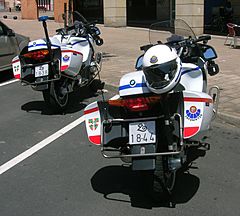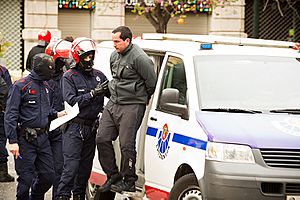Ertzaintza facts for kids
Quick facts for kids People's GuardErtzaintza |
|
|---|---|

Badge of the Ertzaintza
|
|

Flag of the Ertzaintza
|
|
| Agency overview | |
| Formed | 1982 |
| Preceding agency |
|
| Annual budget | US$634.34 million (€570 million) (2015) |
| Jurisdictional structure | |
| Operations jurisdiction | Basque Country, Spain |
| Governing body | Home Office of the Basque Government |
| Constituting instrument |
|
| General nature | |
| Operational structure | |
| Headquarters | Erandio (Biscay), Basque Country, Spain |
| Ertzainas | 8,000 |
| Elected officer responsible |
|
| Agency executive |
|
| Divisions |
List
Citizen Security
Criminal Investigations Intelligence |
| Police Stations |
List
Vitoria-Gasteiz
Llodio/Laudio Laguardia/Guardia Durango Balmaseda Sestao Bilbao/Bilbo Beasain Zumarraga Tolosa Azkoitia Zarautz Hernani Donostia/San Sebastián Errenteria Irun Eibar Bergara Ondarroa Gernika Muskiz |
| Facilities | |
| Stations | 20 |
| Boats | 9 |
| Helicopters | 2 |
| Notables | |
| Anniversaries |
|
| Website | |
| http://www.ertzaintza.eus | |

The Ertzaintza (Basque: [erts̻aints̻a], English: Public Guard or People's Guard), is the autonomous police force for the Basque Country, largely replacing the Spanish Policía Nacional (National Police) and Guardia Civil (Civil Guard). An Ertzaintza member is called an ertzaina (IPA: [erts̻aɲa]).
Contents
History
Origins
The origins of the current Ertzaintza can be traced back to the old municipal militias, which were popular organizations at the service of local bodies, created to satisfy the need for public safety. But it was not until the 19th century when the almost permanent police corps of a professional nature were created.
It was a response to the banditry caused by the continuous social and political upheaval occurring from the end of the 18th century and well into the 19th. The decisive argument for its configuration was the First Carlist War, when the Miqueletes of Biscay and Guipuzcoa and the Miñones of Alava commenced their activities.
Once the urgencies of the war were overcome, the Spanish government attempted to recover the functions carried out by these regional forces and transfer them to the Civil Guard, which was created in 1844. Nevertheless, due to difficulties encountered when recruiting forces for this corps in the Basque provinces, plus the pressure posed by the other regional Governments, the very same regional forces were able to more or less carry on with their task.
After Carlist Wars
After the end of the Second Carlist War (1876), the Spanish government wished to curtail the regional autonomy. The Basque police forces had to adapt to this new centralist tendency, and these changes mostly manifested themselves in a reduction of personnel & operational capabilities.
When the Second Spanish Republic was proclaimed in 1931, political activity surged and so did the Basque claim to re-establish regional liberties that had been abolished in 1876. Thus, various projects for the Autonomy Statute were promoted.
On October 1, 1936, during the Spanish Civil War, the Basque Statute of Autonomy come into force, leading to the establishment of an autonomous government with actual authority over the provinces of Biscay and Guipuzcoa. One of the priorities of the new government was the re-establishment of public order.
The Basque Interior Minister Telesforo Monzón set up several institutions, such as the International Police Force, the Maritime Police and the Public Order Body. Their main task was the creation of a police force named Ertzaña (a Basque neologism for "People care"), with 500 infantry and 400 motorised (Ertzañ Igiletua) men, totalling joint forces of around 1,200 agents. Most of the British Riley Motor cars acquired for the motorised police did not arrive due to the Non-Intervention Pact. The majority of the Ertzaña were Basque speakers from the Basque Nationalist Party Its headquarters were in Bilbao, at the Ibaigane Palace (currently the headquarters of Athletic Bilbao).
When the war on the Basque front concluded, the Ertzaña was dissolved, and Franco's Nationalist regime pretended that this institution had never existed in the first place.
Having allied themselves with the losing Republican side, Biscay and Guipuzcoa were considered "traitor provinces" and most of their autonomy was annulled. However, since at the outbreak of the civil war Alava and Navarre had thrown their lot in with the Nationalists, the Miñones and Miqueletes continued on duty, with assignments such as traffic patrols and custody of the regional institutions.
During transition
After the Spanish transition to democracy, the autonomous Basque Government was restored. Its government once again took up the spirit of the Ertzaña of 1936 to design, in 1980, the new autonomous police force of the Basque Country, the Ertzaintza (a more grammatical form). Previously, a Royal Decree re-established the "Forales" and the "Miqueletes" in Biscay and Guipuzcoa and gave a new configuration to the "Miñones" corps in Alava. These institutions were incorporated into the new Basque Police Force.
Navarre, during the events surrounding Spain's 1978 Constitution, ended up with the status of Autonomous Community and was not lumped in with the Basque autonomous community, and its police force (Policía Foral) remains independent of the Ertzaintza.
Officers
The first officers were members of the Basque Nationalist Party. Although the law required that Ertzaintza commissioned officers had to be previous members of the Spanish army or the State police forces, this was often ignored.
This new police force, made up of Basque citizens, developed in an organized manner from 1982, and was progressively deployed starting from the countryside towards the cities.
Like many other Spanish Military and Police agencies Ertzaintza issues the H&K USP Compact chambered in 9mm.
Rank insignia
| Police Ranks | Facultatives and Technicians Grade | ||||
|---|---|---|---|---|---|
 |
Cap Emblem | ||||
| Rigid Shoulder Plate | |||||
| Flexible Shoulder Plate | |||||
| Rank Insignia | |||||
| Group | Group A1 | Group A2 | Group C1 | Group C2 | |

Etymology
Ertzaña was a Basque neologism from eŕi ("people") and zañ ("guard") created by the Nationalist poet Esteban Urkiaga Lauaxeta. The generic Basque word for "police" is polizia. Following the standardization of Basque in the 1960s, the name of the restored force became "Ertzaintza" from the respelled herri and zain (compare with artzain, "shepherd" from ardi + zain), with the suffix -tza (compare Osakidetza, the Basque health service). However to maintain a link to the past, the silent H was not included. The Basque pop group Hertzainak ("The policemen") chose their name prior to the re-establishment of the corps and applied the modern spelling rules.
See also
 In Spanish: Ertzaintza para niños
In Spanish: Ertzaintza para niños



















